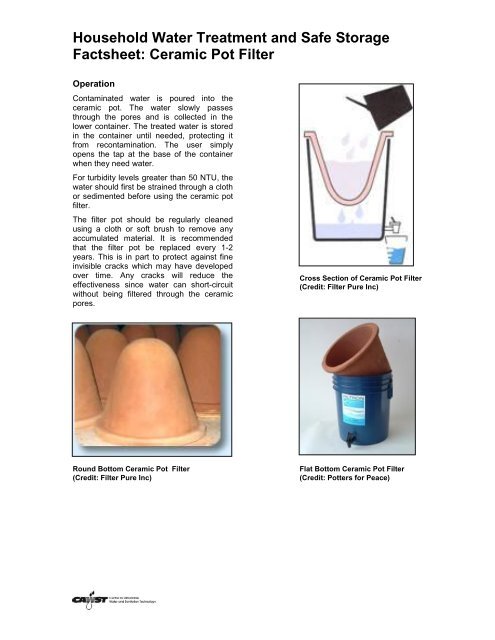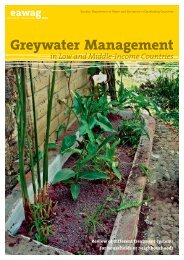Household Water Treatment and Safe Storage Factsheet: Source ...
Household Water Treatment and Safe Storage Factsheet: Source ...
Household Water Treatment and Safe Storage Factsheet: Source ...
You also want an ePaper? Increase the reach of your titles
YUMPU automatically turns print PDFs into web optimized ePapers that Google loves.
<strong>Household</strong> <strong>Water</strong> <strong>Treatment</strong> <strong>and</strong> <strong>Safe</strong> <strong>Storage</strong><br />
<strong>Factsheet</strong>: Ceramic Pot Filter<br />
Operation<br />
Contaminated water is poured into the<br />
ceramic pot. The water slowly passes<br />
through the pores <strong>and</strong> is collected in the<br />
lower container. The treated water is stored<br />
in the container until needed, protecting it<br />
from recontamination. The user simply<br />
opens the tap at the base of the container<br />
when they need water.<br />
For turbidity levels greater than 50 NTU, the<br />
water should first be strained through a cloth<br />
or sedimented before using the ceramic pot<br />
filter.<br />
The filter pot should be regularly cleaned<br />
using a cloth or soft brush to remove any<br />
accumulated material. It is recommended<br />
that the filter pot be replaced every 1-2<br />
years. This is in part to protect against fine<br />
invisible cracks which may have developed<br />
over time. Any cracks will reduce the<br />
effectiveness since water can short-circuit<br />
without being filtered through the ceramic<br />
pores.<br />
Cross Section of Ceramic Pot Filter<br />
(Credit: Filter Pure Inc)<br />
Round Bottom Ceramic Pot Filter<br />
(Credit: Filter Pure Inc)<br />
Flat Bottom Ceramic Pot Filter<br />
(Credit: Potters for Peace)
















